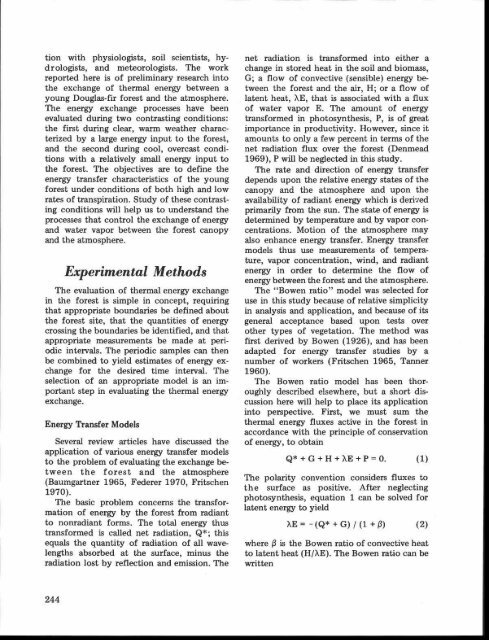PE EIE[R-Rg RESEARCH ON - HJ Andrews Experimental Forest
PE EIE[R-Rg RESEARCH ON - HJ Andrews Experimental Forest
PE EIE[R-Rg RESEARCH ON - HJ Andrews Experimental Forest
You also want an ePaper? Increase the reach of your titles
YUMPU automatically turns print PDFs into web optimized ePapers that Google loves.
tion with physiologists, soil scientists, hydrologists,<br />
and meteorologists . The wor k<br />
reported here is of preliminary research int o<br />
the exchange of thermal energy between a<br />
young Douglas-fir forest and the atmosphere .<br />
The energy exchange processes have bee n<br />
evaluated during two contrasting conditions :<br />
the first during clear, warm weather characterized<br />
by a large energy input to the forest ,<br />
and the second during cool, overcast conditions<br />
with a relatively small energy input to<br />
the forest. The objectives are to define th e<br />
energy transfer characteristics of the youn g<br />
forest under conditions of both high and lo w<br />
rates of transpiration . Study of these contrasting<br />
conditions will help us to understand the<br />
processes that control the exchange of energy<br />
and water vapor between the forest canop y<br />
and the atmosphere .<br />
<strong>Experimental</strong> Methods<br />
The evaluation of thermal energy exchange<br />
in the forest is simple in concept, requirin g<br />
that appropriate boundaries be defined abou t<br />
the forest site, that the quantities of energ y<br />
crossing the boundaries be identified, and that<br />
appropriate measurements be made at periodic<br />
intervals . The periodic samples can the n<br />
be combined to yield estimates of energy ex -<br />
change for the desired time interval . Th e<br />
selection of an appropriate model is an important<br />
step in evaluating the thermal energy<br />
exchange .<br />
Energy Transfer Models<br />
Several review articles have discussed th e<br />
application of various energy transfer model s<br />
to the problem of evaluating the exchange between<br />
the forest and the atmosphere<br />
(Baumgartner 1965, Federer 1970, Fritsche n<br />
1970) .<br />
The basic problem concerns the transformation<br />
of energy by the forest from radiant<br />
to nonradiant forms . The total energy thus<br />
transformed is called net radiation, Q* ; this<br />
equals the quantity of radiation of all wavelengths<br />
absorbed at the surface, minus th e<br />
radiation lost by reflection and emission . The<br />
net radiation is transformed into either a<br />
change in stored heat in the soil and biomass ,<br />
G; a flow of convective (sensible) energy between<br />
the forest and the air, H; or a flow of<br />
latent heat, AE, that is associated with a flux<br />
of water vapor E . The amount of energy<br />
transformed in photosynthesis, P, is of great<br />
importance in productivity . However, since i t<br />
amounts to only a few percent in terms of the<br />
net radiation flux over the forest (Denmead<br />
1969), P will be neglected in this study .<br />
The rate and direction of energy transfer<br />
depends upon the relative energy states of th e<br />
canopy and the atmosphere and upon th e<br />
availability of radiant energy which is derived<br />
primarily from the sun . The state of energy is<br />
determined by temperature and by vapor concentrations.<br />
Motion of the atmosphere may<br />
also enhance energy transfer . Energy transfer<br />
models thus use measurements of temperature,<br />
vapor concentration, wind, and radian t<br />
energy in order to determine the flow of<br />
energy between the forest and the atmosphere .<br />
The "Bowen ratio" model was selected for<br />
use in this study because of relative simplicity<br />
in analysis and application, and because of its<br />
general acceptance based upon tests over<br />
other types of vegetation . The method was<br />
first derived by Bowen (1926), and has been<br />
adapted for energy transfer studies by a<br />
number of workers (Fritschen 1965, Tanner<br />
1960) .<br />
The Bowen ratio model has been thoroughly<br />
described elsewhere, but a short discussion<br />
here will help to place its applicatio n<br />
into perspective . First, we must sum th e<br />
thermal energy fluxes active in the forest i n<br />
accordance with the principle of conservatio n<br />
of energy, to obtain<br />
Q*+G+H+XE+P=0 . (1)<br />
The polarity convention considers fluxes t o<br />
the surface as positive . After neglectin g<br />
photosynthesis, equation 1 can be solved for<br />
latent energy to yield<br />
XE = - (Q* + G) / (1 + (3) ( 2)<br />
where i3 is the Bowen ratio of convective hea t<br />
to latent heat (H/XE). The Bowen ratio can be<br />
written<br />
244








